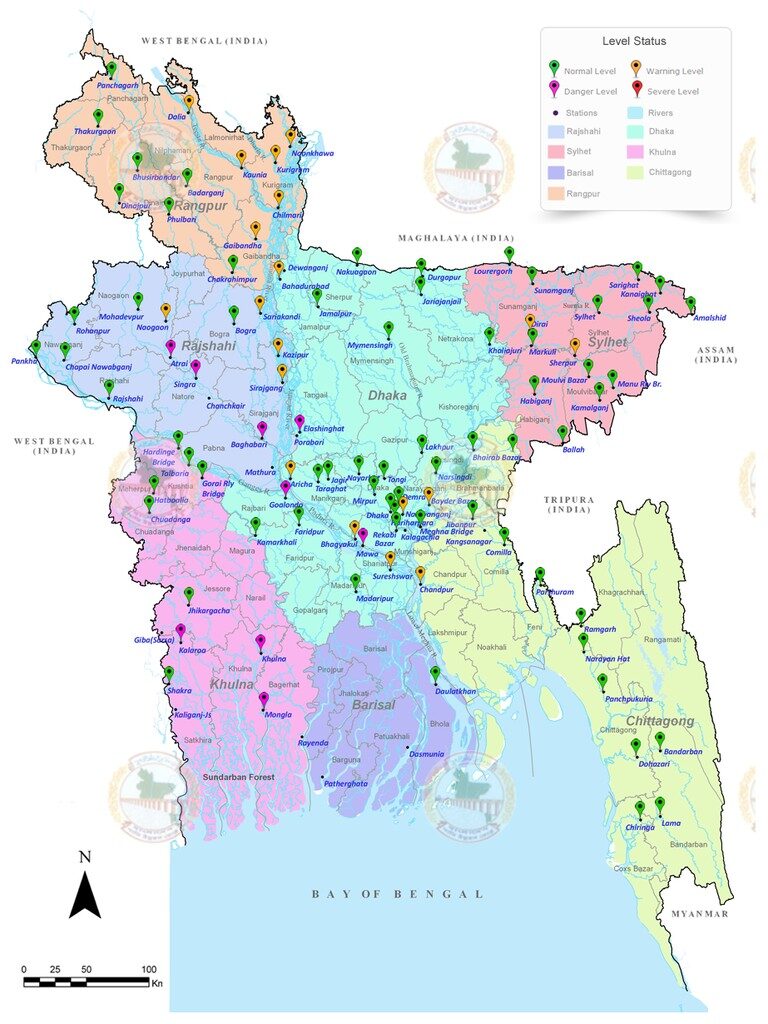Flooding hit several northern districts of the country in late June after heavy rain in the country and in river catchments in neighbouring India. Jamalpur, Kurigram and Gaibandha districts were the worst affected, with some flash flooding also reported in Sylhet and Sunamganj districts.
Since then flooding has been reported in a further 8 districts. According to a report by Network for Information, Response And Preparedness Activities on Disaster (NIRAPAD) of 04 July, a total of 1,012,775 people have been affected and 221,158 households marooned. The affected districts include: Lalmonirhat, Kurigram, Gaibandha, Nilphamari, Rangpur, Sunamganj, Sirajganj, Bogura, Jamalpur, Sylhet, Tangail, Rajbari and Madaripur.
Floods Could Affect Over 7 Million
As of 08 July, rivers were above the danger mark in at least 9 locations, according to the Flood Forecasting and Warning Centre of the Bangladesh Water Development Board (BWDB).
Some rivers in the north have shown signs of falling over the last 2 days. Bangladeshi news agency BSS reported some of those displaced by flooding in northern districts were able to return home.
However, flooding has been forecast to worsen over the course of July as water makes its way downstream from currently flooded areas of neighbouring India. Recent heavy rainfall in Bangladesh has complicated the situation further. The districts of Gaibandha, Sunamganj and Sylhet all recorded more than 300mm of rain in the first 7 days of July.
According to the analysis of Needs Assessment Working Group of Bangladesh, a possible 7.5 million people could be affected by the worsening floods, with 1.37 million homes thought to be vulnerable.
EU Aid
The European Union has provided Euros 100,000 for reducing the negative impacts of flooding. The aid will benefit over 3,300 families in some of the hardest flood hit areas in Kurigram, Gaibandha and Jamalpur districts.
The aid would be used in evacuating the most vulnerable communities to safe shelters with their assets and livestock, providing unconditional cash grants, as well as providing first aid treatment.
The funding will also support the Bangladesh Red Crescent Society in using reliable scientific forecast information and risk analysis to foresee the potential impact of the floods and to conduct early actions aimed at reducing human suffering, losses and damage.
Social Media
Flood caused by heavy rains has seriously affected some parts of Bangladesh on July 2,2020. #WorldNews pic.twitter.com/RL87b8L6F0
— CCTV (@CCTV) July 3, 2020
🤝Our mapping and early warning system work together for #Bangladesh 🇧🇩 flood preparation and response!
— Copernicus EMS (@CopernicusEMS) July 2, 2020
1⃣ Bangladesh flood forecasting from #GLOFAS helps prioritise vulnerable areas.
2⃣ #RapidMapping supports disaster response.
Find out more here ➡️ https://t.co/03H6wiXByF pic.twitter.com/gyshd7vQbb




Reader Comments
to our Newsletter